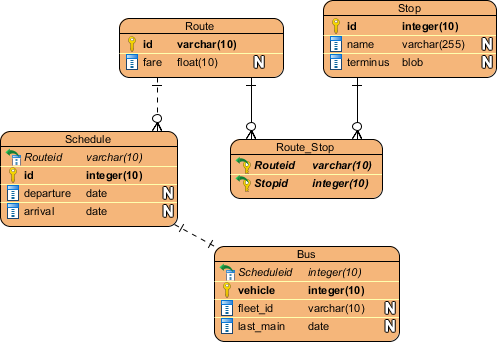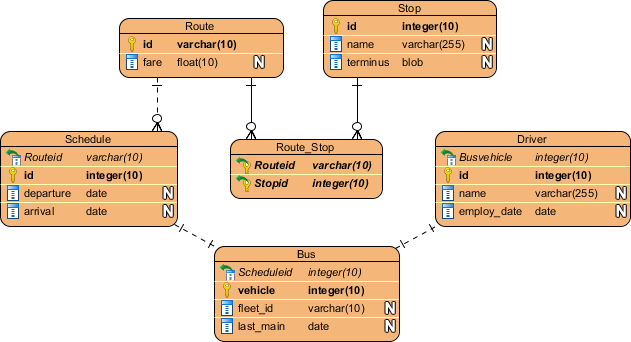Entity relationship diagram (ERD)
is a kind of diagram for presenting visually the structure of
relational database. In this tutorial we will make use of the ERD tool
to model the database structure of a simple bus route management system.
Rate this Article
Click on one of the stars below to rate this article from 1 (lowest) to 5 (highest).
Comments (37)
Good easy to follow example for someone like me just starting/learning.
It appears the instructions above for 14 creating the entity Bus are incorrect
(should be- vehicle_id not id).
Also
15 (should be- Finally, create entity Driver from Bus, with an
one-to-one relationship. Create the following columns in Driver.)
Looks wrong
15. A bus is driven by a bus driver. Finally, create entity from Bus with a one-to-one relationship.
Create an entity Bus from Schedule, with an one-to-one relationship. Create the following
columns in Bus:
Using this sample, can you tell me how I
would show which tables contribute to a view. I've created a view
entity but I'd like to show which tables make up the view visually but
don't see a way to do that. Thanks in advance.
this is very easy to understand who is initially learners for E-R diaghrams
Hi Richard and Bartek,
Thank you for pointing out the mistakes. All issues are now fixed.
Best regards,
Jick Yeung
excellent tutorial for basic learners of E-R diagram in visual paradigm
The way of explanation is good,
and easy to follow for a beginner like me.
regards,
ash
Excellent tool for generating ERDs, I'm sure my students will make great use of this tool.
In the entity diagram J have a primary key, and J wanna to have a secundary key in a new column, how to do that?
Sorry about my english.
hhhh in the relationship specification
we can mark the colum from some entity with the foreign key (at school
we caled it secundary key, it is more logicaly :) and at the screen he
apear with the green arrow !
Thanks anyway!
Is it also possible to show user types in the diagram?
I can't find any setting to realize that.
Dear JouBSTi,
You can show the user type defined in column specification window. Please try this:
1. Right click on the background of diagram
2. Select "Presentation Options > Entity Columns Display Options > Show Column User Type" from the popup menu.
Best regards,
Jick Yeung
Hi!
Does anyone know how to implement "IS-A" in ERD using VP?
how to create one-to-one optional in ERD through uml pairadigm
Hi sohaib,
You can set the
cardinality via the specification of a relationship. Try this: Create a
one-to-one. Right click on the connector and select Open
Specification... from the popup menu. In the specification window,
select "Zero or One" as the Cardinality of the to-side.
Best regards,
Jick Yeung
I am asking again & again how to
create database for .net & mysql because everywhere u r creating
database for java because i am not getting what is to be select in
adapter & driver place when i am going through tools then database
configuration (after creating ER Diagram) & i sent alot of mails
regarding this but no body didnt reply for this & same for how to
create class diagram using ER diagram.
Hi Richa,
You can simply press
the Green Arrow button next to the Driver file and Adapter file field to
let VP download the files for you. Please make sure you have run the
application with Admin permission (right click on the executable and
select Run as administrator), and also with proper proxy server setting
specified (if you need proxy for access Internet).
BTW, we seems
only receive 2 email request from you. As I know our support team are
checking with you about your other requests. Feel free to contact us for
any questions.
Best regards,
Rain Wong
I have a question:
Now think about a University in terms of an ERD. What entities, relationships and attributes might you consider.
Thanks for your support.
Hi Muhumuza,
Thank you for your
post. I am afraid there is no definite answer because it depends on the
system you are going to develop. Could you tell me more about your case?
I regret that we do not help our
clients finish their works. But if you have any questions when you are
drawing your ERD, you can ask and we will try our best to help.
nice example thanks for this i have an idea for my project :D
this system is actually amazing. does
fleet_id in bus and id in driver are the same? if not could you please
explain me the difference between the two? also kindly let me know what
is last_main in bus? as i'm a beginner, I couldn't understand few
concepts fully. thanks in advance
Hi PL Sivakami,
fleet_id in bus
and id in driver are different. Let's say if a bus belong to a fleet
called "Dragon", then it may have "DRG" as its fleet ID. id of driver is
for uniquely identifying every single driver in the bus company.
last_main stands for the last maintenance date. As you can see, it's in
"date" type because its value is supposed to be a date.
I have a dfd and that im in a big confusion that how do i change that dfd to an er diagram can any one help me out
Thanks in advance
Hi,
How Can I create SuperType and SubType in ERD?
It's suppose to become an abstract class in the class diagram (in UML diagram).
Thanks in advanced,
Elad
Pls help me to draw a ER Diagram for a website pl
Hi Swati,
Thank you for your
post. Please submit a ticket to our support team. We can discuss your
case and pricing in details. To submit a ticket please visit:
http://www.visual-paradigm.com/support/
I dnt know ERD.plz help me and tell me easy method
plz help me draw a ERD and where it use it?plz tell me all information about ERD?
I am trying to display column user type in the document and cannot find the property name for it.
I am trying to display column user type in the document and cannot find the property name for it.
Which kind of Attribute is the date? PLZ Answer as soon as possible
Thanks
You can use
date
String (store YYYY-MM-DD)
int
Oi, senti falta do tipo "serial" do PostgreSQL.
Hi Brendo ,
You can create an
int/bigint primary key column with native/identity id generator. This
means an "auto increment int". It will be converted to serial when
generating DDL.
What is the RouteId doing in schedule? I
also have that symbol in my diagram, but couldn‘t you just create the
relation without that?




 / 293
/ 293











Comments (37)
It appears the instructions above for 14 creating the entity Bus are incorrect
(should be- vehicle_id not id).
Also 15 (should be- Finally, create entity Driver from Bus, with an one-to-one relationship. Create the following columns in Driver.)
15. A bus is driven by a bus driver. Finally, create entity from Bus with a one-to-one relationship.
Create an entity Bus from Schedule, with an one-to-one relationship. Create the following
columns in Bus:
Thank you for pointing out the mistakes. All issues are now fixed.
Best regards,
Jick Yeung
and easy to follow for a beginner like me.
regards,
ash
Sorry about my english.
Thanks anyway!
I can't find any setting to realize that.
You can show the user type defined in column specification window. Please try this:
1. Right click on the background of diagram
2. Select "Presentation Options > Entity Columns Display Options > Show Column User Type" from the popup menu.
Best regards,
Jick Yeung
Does anyone know how to implement "IS-A" in ERD using VP?
You can set the cardinality via the specification of a relationship. Try this: Create a one-to-one. Right click on the connector and select Open Specification... from the popup menu. In the specification window, select "Zero or One" as the Cardinality of the to-side.
Best regards,
Jick Yeung
You can simply press the Green Arrow button next to the Driver file and Adapter file field to let VP download the files for you. Please make sure you have run the application with Admin permission (right click on the executable and select Run as administrator), and also with proper proxy server setting specified (if you need proxy for access Internet).
BTW, we seems only receive 2 email request from you. As I know our support team are checking with you about your other requests. Feel free to contact us for any questions.
Best regards,
Rain Wong
Now think about a University in terms of an ERD. What entities, relationships and attributes might you consider.
Thanks for your support.
Thank you for your post. I am afraid there is no definite answer because it depends on the system you are going to develop. Could you tell me more about your case?
fleet_id in bus and id in driver are different. Let's say if a bus belong to a fleet called "Dragon", then it may have "DRG" as its fleet ID. id of driver is for uniquely identifying every single driver in the bus company. last_main stands for the last maintenance date. As you can see, it's in "date" type because its value is supposed to be a date.
Thanks in advance
How Can I create SuperType and SubType in ERD?
It's suppose to become an abstract class in the class diagram (in UML diagram).
Thanks in advanced,
Elad
Thank you for your post. Please submit a ticket to our support team. We can discuss your case and pricing in details. To submit a ticket please visit:
http://www.visual-paradigm.com/support/
Thanks
date
String (store YYYY-MM-DD)
int
You can create an int/bigint primary key column with native/identity id generator. This means an "auto increment int". It will be converted to serial when generating DDL.